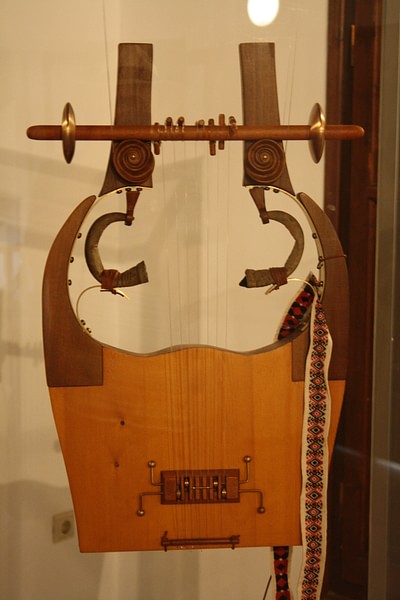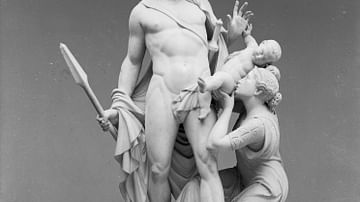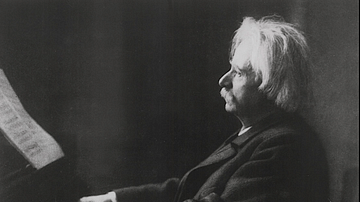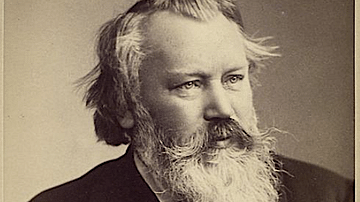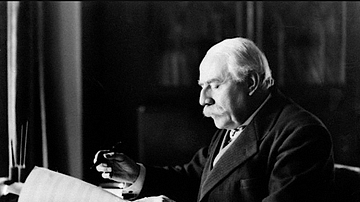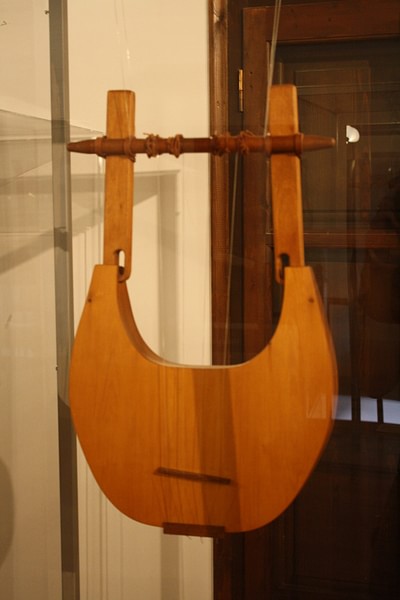
Lasus of Hermione was a celebrated 6th century BCE Greek lyric poet and musician credited with making significant innovations in Greek music. The Suda (a large Byzantine record from the 10th century CE) dates his birth to the 58th Olympiad (548-44 BCE).
Lasus was based in Athens under the patronage of the tyrant Hipparchus, making him a contemporary of Simonides. In Aristophanes' Wasps it is claimed that the two met in contest, but this reference says little of the two's relationship, “Lasus and Simonides were contesting against each other for the singing prize. Lasus said, 'Damned if I care'." (Wasps 1411).
One of Lasus' most important innovations was the popularisation in Athens of a choral song and dance in honour of the wine god Dionysos known as the dithyramb. According to Plutarch, it was in Athens where Lasus officially introduced the Great Dionysia, which was a dithyrambic competition. The Parian Chronicle, an ancient Greek document, dates this event to 509-8 BCE, which would have been after his patron's death.
Lasus is also claimed to have implemented 'asigmatism', a poetical technique that either refers to the complete abstinence of the Dorian letter 'san' (the Dorian word for 'sigma', our 's') from dithyrambs, or of its partial abstinence, which seems more to be what is meant by the term since, from a practical point of view, 's' is a very common Greek letter. One of the few works which makes reference of this technique comes from the Greek poet Pindar who wrote for a performance in Thebes, “In earlier times the song of the dithyrambs crept along, stretched out like a rope, and the 's' came out base-born from men's mouths…”. (Pindar fr. 61.1-21).
This fragment of Pindar is found on both an ancient manuscript known as the Oxyrinchus Papyrus, and as being quoted by Dionysius of Halicarnassus in his work On the Composition of Words. It is interesting to note that one of our only contemporary sources that makes reference to 'asigmatism' is by Pindar, and that he seemingly doesn't think highly of the technique, since Lasus is said to have been his teacher. The reason for Lasus introducing such a technique is never directly addressed, but Atheneaus, quoting Aristoxenus, says that the reason for earlier unnamed musicians' rejection of 's' was because it was “difficult to pronounce”, “harsh-sounding”, and “ill-suited to the aulos”, a pipe which accompanied the dithyramb (Ath.11.467a), and when Dionysius quotes Pindar it is to support his claim that “some of the ancient writers used the sigma sparingly and with caution, some even composing entire odes without sigmas”. Lasus could well have been one of these 'ancient writers'.
Lasus was also attributed with improvements to auletic technique:
Lasus of Hermione, by altering the rhythms for the movement of the dithyramb, and by pursuing the example of the multiplicity of the note belonging to the aulos (and so making use of more notes, widely scattered about), transformed the music that existed before him. (Ps.-Plut. 1141c, cf. school. to Pindar, Ol. 13.26)
This probably means that Lasus modulated between harmonia, though this technique is more related to 5th century BCE music. It is notably rare that a Greek music theorist should also be a musician, as is the case with Lasus, since he was one of the first notable musicologists. However, his work does not survive, but he is referred to as belonging to Epigonus' school of thought with regards to pitch. The inner musicologist can be seen not only in Lasus' subscription to 'asigmatism', but also by reference to his decision to use an atypical mode in his own pieces, or possibly by showing his ability to identify and use it: “of Demeter I sing, and the maiden, Klymenos' consort, raising a hymn of honey cry in the deep-resounding Aeolian attunement…”, which M.L.West says is like singing “let us praise the Lord with one voice in G major”. This is the only surviving fragment of Lasus, preserved through Ath.14.624e where it is referred to as being mentioned by Heraclides of Pontus in the third book of his work On Music.
Outside of a musical context Herodotus makes note of Lasus as being the person who caught Onomacritus of Athens inventing a prophecy of Musaeus, about how the islands of the coast of Lemnos would be submerged by the sea one day, which resulted in Onomacritus being banished from Athens by Hipparchus (Hdt. 7.6.3-5).
What little evidence that can be gleaned from the ancient sources about Lasus of Hermione shows him to have been an influential and innovative musician in Athens in the late 6th C. BCE. It only remains to wish that more of his writings and music might be found, so that we can better understand such a vital figure in the development of Greek music.
